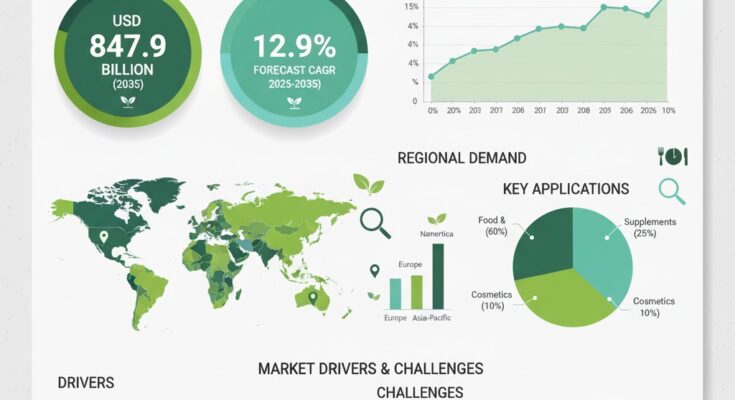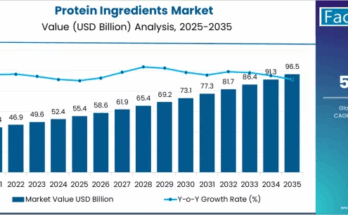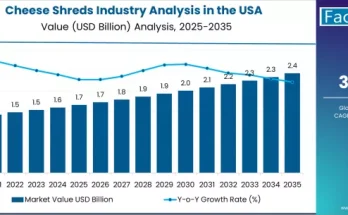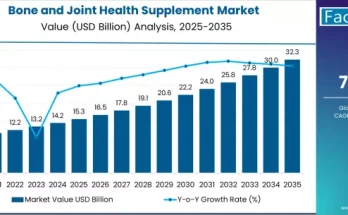The global organic food ingredients market is witnessing unprecedented expansion as consumers, manufacturers, and retailers embrace clean-label products and sustainable food production. According to a recent report by Fact.MR, the market is projected to grow from USD 252.0 billion in 2025 to approximately USD 847.9 billion by 2035, recording an absolute increase of USD 702.2 billion over the forecast period. This translates into a total growth of 278.7%, with the market expected to expand at a compound annual growth rate (CAGR) of 12.9% between 2025 and 2035.
Rising health consciousness, evolving dietary preferences, and stringent regulations on chemical inputs in food production are steering the market toward sustained growth. As consumers seek transparency and traceability in what they consume, food manufacturers are responding with expanded organic portfolios across categories such as dairy, grains, fruits, vegetables, beverages, and snacks.
Strategic Market Drivers
- Rising Demand for Health and Wellness Products
The global health revolution is reshaping consumer purchasing patterns. Growing awareness of the health risks associated with synthetic additives, pesticides, and GMOs is prompting consumers to shift toward organically sourced food ingredients. The “clean eating” movement, reinforced by social media and influencer-driven campaigns, is further fueling demand for natural, chemical-free, and minimally processed products.
- Expansion of the Clean Label Movement
Manufacturers are under increasing pressure to reformulate products using organic and recognizable ingredients. Clean-label trends—emphasizing short ingredient lists, transparency, and environmental accountability—are driving innovation in organic sweeteners, natural colors, plant-based proteins, and preservatives. This trend is particularly prominent in bakery, beverage, and baby food categories.
- Government Regulations and Incentives
Governments worldwide are strengthening organic certification systems and incentivizing farmers to adopt sustainable agricultural practices. Initiatives such as the EU’s Farm to Fork Strategy, the USDA Organic Certification Program, and India’s National Programme for Organic Production (NPOP) are fostering both supply chain integrity and consumer trust in organic food products.
- Growth of E-commerce and Direct-to-Consumer Channels
Digitalization is reshaping the organic food ecosystem. Online grocery platforms and health-focused delivery services are expanding access to organic products, bridging urban-rural divides. This trend has been accelerated by post-pandemic shopping behavior, where convenience and safety play a key role in purchasing decisions.
- Technological Integration and Sustainable Sourcing
Advancements in precision agriculture, blockchain traceability, and AI-driven supply chain management are transforming how organic ingredients are produced and distributed. Manufacturers are increasingly investing in regenerative farming, eco-friendly packaging, and carbon-neutral logistics to enhance sustainability across the value chain.
Regional Growth Highlights
North America: The Organic Pioneer
North America remains the leading market for organic food ingredients, driven by robust consumer awareness, strong retail presence, and established certification frameworks. The United States, in particular, continues to see double-digit growth in organic packaged food and beverages, supported by brands like Whole Foods, Amy’s Kitchen, and Annie’s (General Mills).
Europe: Regulation-Driven Market Maturity
Europe is witnessing sustained market growth, underpinned by stringent environmental policies and consumer preference for ethically sourced products. Countries such as Germany, France, and the UK are at the forefront of organic retail expansion, supported by government-backed eco-labels and increased investments in sustainable farming.
Asia Pacific: The Emerging Powerhouse
Asia Pacific is emerging as a key growth frontier, fueled by rising disposable incomes, rapid urbanization, and growing awareness of food safety. Markets such as India, China, and Japan are witnessing a surge in organic ingredient imports, while local production of organic grains, pulses, and spices continues to expand under government incentives.
Latin America and the Middle East: Rising Production and Export Hubs
Latin America’s vast agricultural base positions it as a leading exporter of organic coffee, cocoa, and tropical fruits. Meanwhile, the Middle East is increasingly investing in organic imports and local production initiatives to meet the rising demand among health-conscious consumers.
Market Segmentation Insights
By Ingredient Type
- Organic Grains & Cereals: Leading the market due to high consumption in everyday staples and bakery applications.
- Organic Fruits & Vegetables: Rapidly growing segment driven by fresh produce and juice industries.
- Organic Dairy Ingredients: Demand supported by increased preference for hormone-free milk and yogurt.
- Organic Meat & Poultry: Gaining momentum with consumers seeking ethically raised, antibiotic-free proteins.
- Organic Additives (Sweeteners, Preservatives, Colors): Used extensively in processed and packaged foods.
By Application
- Food & Beverages: Dominant sector with strong demand across bakery, snacks, and dairy products.
- Nutraceuticals: Growing importance of organic supplements in preventive healthcare.
- Cosmetics & Personal Care: Expanding application in skincare and wellness products due to natural ingredient appeal.
Challenges and Market Considerations
Despite its strong outlook, the organic food ingredients market faces several challenges:
- Higher Production Costs: Organic farming requires more labor and time, raising input costs.
- Supply Chain Fragmentation: Inconsistent certification and traceability standards across regions hinder trade.
- Price Sensitivity: Premium pricing limits accessibility in developing economies.
- Climate and Yield Variability: Dependence on natural cultivation methods exposes producers to environmental risks.
Competitive Landscape
The organic food ingredients market is highly competitive and innovation-driven, with key players focusing on product diversification, sustainable sourcing, and partnerships with farmers and retailers.
Key Players in the Organic Food Ingredients Market include:
- Organic Valley
- Amy’s Kitchen
- Hain Celestial Group
- Whole Foods (Amazon)
- Earthbound Farm
- Eden Foods
- SunOpta
- Organic India
- Nature’s Path Foods
- General Mills (Annie’s)
These companies are leading the transition toward organic ecosystems by integrating sustainability across their operations—from regenerative agriculture to biodegradable packaging and carbon-neutral logistics.
Maufracture’s Strategic Positioning
Maufracture seeks to capture this growth momentum through:
- Innovation in Organic Formulations: Developing certified organic ingredients that enhance nutritional value and flavor authenticity.
- Global Expansion: Strengthening presence in emerging Asian and Latin American markets through local partnerships and farmer integration programs.
- Sustainability Commitment: Embracing regenerative sourcing, waste minimization, and eco-efficient packaging.
- Collaborations with Food Brands: Partnering with global food producers to co-create clean-label products that align with consumer values.
Future Outlook: Building a Sustainable and Transparent Food Ecosystem
The next decade will redefine the global food industry through the lens of sustainability, health, and ethics. The organic food ingredients market is set to play a central role in this transformation—offering consumers safer, healthier, and environmentally responsible food choices.
Manufacturers that align innovation with transparency, traceability, and circular economy principles will lead this evolution. With a strong foundation in sustainable sourcing, R&D, and strategic alliances, Maufracture is positioned to drive the future of organic food ingredients—delivering nourishment that’s as good for people as it is for the planet.



